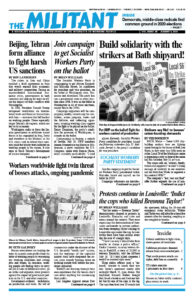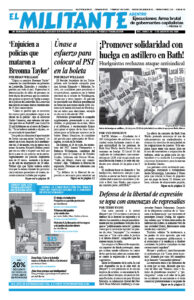The rulers in Iran and China reached a draft agreement in June that would expand their economic and military cooperation. Facing an unprecedented international economic crisis, governments in both countries are looking for ways to offset the impact of their conflicts with Washington.
In 2018, President Donald Trump reimposed restrictions on international trade and financial transactions with Iran — measures that fall hardest on working people. These especially target Tehran’s oil exports, which are key to its economy.
Washington seeks to force the Iranian government to withdraw armed forces it has expanded in Iraq, Syria and elsewhere in the Mideast, as the U.S. rulers seek to defend their interests amid the bloody wars inflicted on working people in the region. It also aims to block Tehran’s development of nuclear weapons.
The Chinese rulers — who preside over the second largest capitalist economy and one of the fastest growing — face serious obstacles to expanding their trade, financial and military influence in Asia and beyond. They are trying to counter Washington’s control of trade routes in the South China Sea — conquered by the U.S. rulers in their victory in the second imperialist world war. Beijing also faces growing conflicts with the rulers in India and other allies of Washington in the region.
The U.S. military announced at the beginning of July shifts in troop deployments to Guam, Hawaii, Alaska, Japan and Australia. U.S. National Security Adviser Robert O’Brien wrote at the end of June that in the Indo-Pacific theater, with Beijing’s rise, “Americans and allies face the most significant geopolitical challenge since the end of the Cold War.”
Tehran’s efforts to get EU powers to help it get around Washington’s crippling sanctions have failed.
Faced with growing conflicts with Washington, the Chinese and Iranian rulers are seeking relief through joint cooperation.
U.S. sanctions, crisis hit Iranian people
The U.S.-led sanctions on Iran have been choking off revenue-earning oil exports. Earlier this month the Iranian currency, the rial, fell to an all-time low against the dollar. The annual inflation rate is estimated at 34%, with the cost of basic necessities like bread, rice and meat rising daily.
The draft agreement between Beijing and Tehran would allow Beijing to buy discounted oil from Iran. In return, the Chinese government promises to invest up to $400 billion in oil, gas and other infrastructure projects in Iran.
The pact would allow Chinese companies to finance, and potentially gain control of, port facilities at Jask in southeast Iran. This is just outside the strategically vital Strait of Hormuz at the mouth of the Arab-Persian Gulf, a choke point for a fifth of world crude oil shipments.
The militaries of the two countries would also collaborate more closely with joint exercises and common weapons development. It is this prospect that is setting off most alarm bells in Washington.
“We have been unambiguous about enforcing” sanctions on Iran, Secretary of State Mike Pompeo said July 15, in response to the announcement of the draft pact. He reiterated Washington’s determination to sanction Chinese businesses that trade with Iran.
Protests in Iran
The Iranian rulers continue to confront protests by working people at home. On July 16, the day after a court upheld the death penalty for three young men arrested during widespread anti-government demonstrations last year, protesters took to the streets in the southwestern city of Behbahan in Khuzestan province to demand a halt to the executions.
Security forces made several arrests. Regime forces also mobilized to prevent protesters from gathering in the capital, Tehran, as well as in Isfahan, Shiraz, Mashhad and Rasht. On July 19 the Iranian judiciary suspended, for now, the three executions.
The Iranian rulers fear a renewal of the massive protests by working people that swept the country last November. The actions were triggered by the impact of the growing international capitalist crisis, plummeting oil prices and by mounting opposition to the Iranian rulers’ military interference across the Mideast. The demonstrators drew strength from the large street actions that broke out in Iraq and Lebanon at the same time. Their key demands included a halt to Tehran’s intervention.

